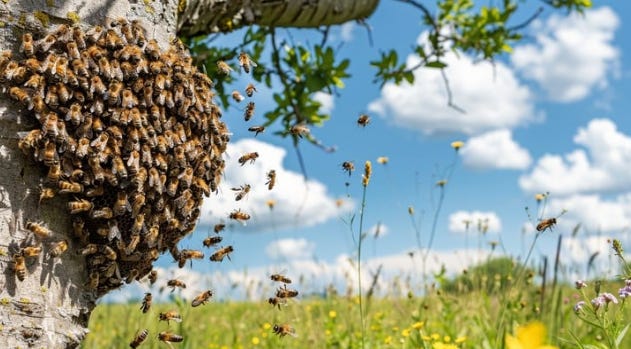The Intelligence Of the Swarm
If President Trump is merely erratic, we can dismiss him. If he’s authoritarian, we can fear him. But what if he’s something else entirely?
What if President Trump plays the role of a lead scouting bee in a collective decision-making system — a swarm with no central brain, but deep internal coherence?
In the 1950s, German zoologist Martin Lindauer, a student of Karl von Frisch (who famously decoded the honeybee’s waggle dance), studied how bee colonies make one of their most consequential decisions: where to go next.
When a hive becomes overcrowded, it must relocate to survive. Scout bees disperse in all directions in search of a new nesting site. Upon returning, each scout performs a waggle dance encoding not just the location but the quality of the site — a visible expression of preference and conviction.
The swarm doesn’t move immediately. It watches. Other scouts check out the proposed sites. Some return to reinforce certain dances. Others don’t. Eventually, through a decentralized process of feedback, recruitment, and repetition, consensus emerges. Then the swarm moves.
This model is strikingly similar to the political dynamic Trump has cultivated.
Trump probes. He provokes institutions and tracks their responses. He floats ideas — sometimes contradictory — not always to enforce them, but to test what gains traction, what triggers pushback, and what resonates with the public's instincts.
This isn’t the behavior of a policy architect. It’s the behavior of a strategic signaler — a lead scout. And critically, Trump is not acting alone.
Behind him, and often ahead of him, is a constellation of actors: governors, pundits, entrepreneurs, judges, influencers, parents, and industrialists. Many don’t answer to him. Some disagree with him. But they’re attuned to the same signals — each performing their own version of the dance.
This is a kind of distributed swarm intelligence — unpredictable, self-correcting, and often dismissed as incoherent by those still tethered to the old model.
Our institutions are full of cave-dwellers — scholars, bureaucrats, and advisors staring at shadows on the wall, mistaking flickers for reality, unable to perceive the structure emerging beyond their frame of reference.
We are used to centralized decision-making. Bureaucracies. Chains of command. We struggle to see a structure so fundamentally different — decentralized, emergent, and adaptive. Most of us are not entrepreneurs.
From a honeybee’s perspective, Trump’s political role isn’t to command or to unify. Nor is it to restore the old system. It’s to move the hive — to push Western civilization from one existential condition to another.
In this light, Trump’s utility isn’t in being the leader of a movement. It’s in agitating the alignment necessary for a new one. His value lies in provoking system-wide feedback, amplifying emerging convictions, and accelerating the search for a new nesting site — regardless of whether he leads the final migration.
Like the lead scout bee, he may not control the swarm. But he may be the reason it moves.
Consider Peter Thiel. Co-founder of PayPal and Palantir, he supported Trump in 2016. Though more reserved today, he remains deeply committed to the broader movement. Thiel was instrumental in JD Vance’s pivot to Trumpism, even arranging their introduction.
Palantir — a platform built to detect patterns in massive data flows — is tailor-made for interpreting the reactions of the swarm. In a recent interview, Thiel said he’s never been more hopeful about America’s future. He believes that we’re in the early stages of a massive phase shift.
The hive must move before the rain comes - or said in other words, before unsustainable debt, brittle supply chains, and a hollowed-out middle class make stagnation irreversible.
It’s probably neither no coincidence that Alexander Karp, Palantir’s CEO and Peter Thiel’s close friend, invokes the honeybee model in The Technological Republic — in order to restore American technological, military, and political dominance.
Seen through this lens, what we’re witnessing isn’t chaos.
It is emergence.



